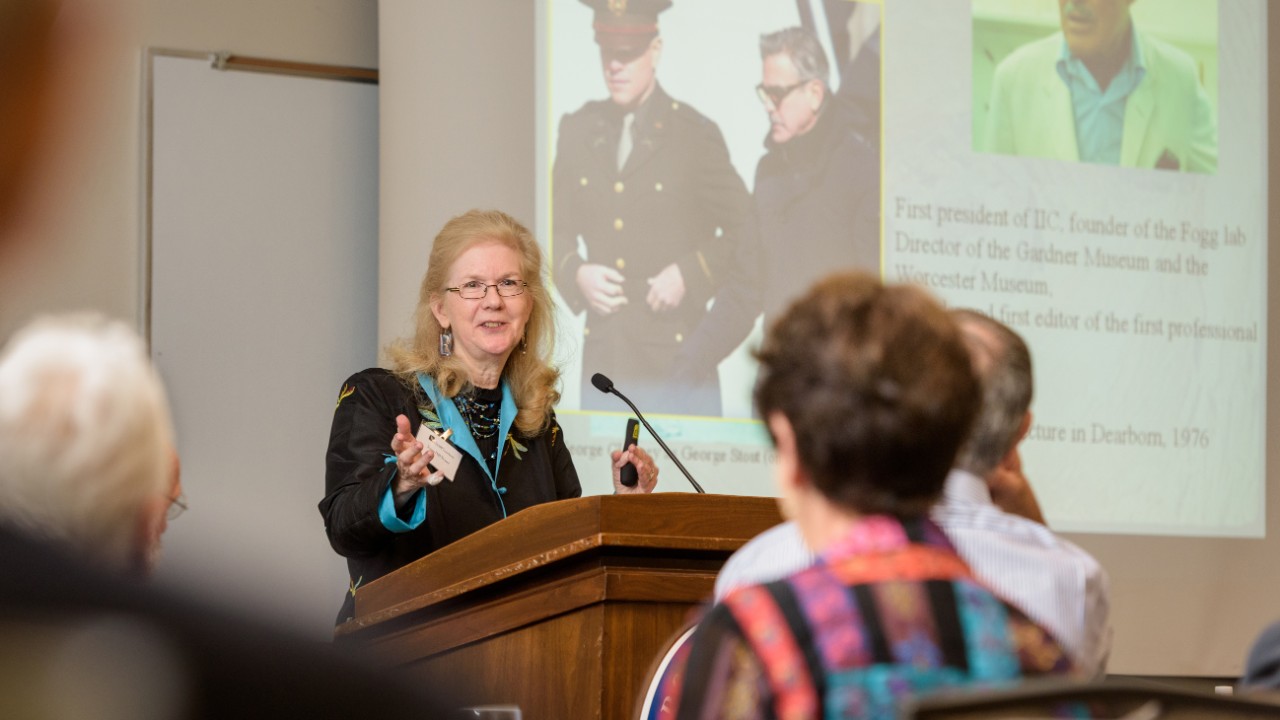


UDARF talk
Photo by Evan Krape October 19, 2016
Joyce Hill Stoner discusses art conservation, working with Andrew Wyeth
As an academic, art conservator and conservator for one of America's most storied artistic families, Joyce Hill Stoner continues to instruct and inspire future preservation leaders.
Stoner, the Edward F. and Elizabeth Goodman Rosenberg Professor of Art Conservation at the University of Delaware, discussed her career and the development of art conservation during a talk given to members of the University of Delaware Association of Retired Faculty at a luncheon held Wednesday, Oct. 5, in Clayton Hall.
"Art conservation has always been around in some form, but it really took off as a profession during the late 19th century," Stoner said. "It was about this time that artists, who had served in some capacity as restorers in the past, separated from the professional conservation and restoration specialists."
The profession traces its origins to Germany in 1888, when Friedrich Rathgen was employed as a chemist by the Royal Museums of Berlin (Staatliche Museen), in Berlin.
In America, the emergence of the art conservation movement grew under the leadership of George L. Stout, Stoner said.
"George Stout was the first president of the International Institute for Conservation of Historic and Artistic Works (ILC), and he also founded the Fogg Laboratory at Harvard University," Stoner said. "There were restorers already working and there were scientists doing paint analysis, but they didn't work together until the Fogg Laboratory was established."
Stout, who established Technical Studies, the first technical journal of art conservation, believed that art conservation is a three-legged stool, consisting of science, art history and practical studio work, Stoner said.
While techniques have improved over the years, the role of conservators remains that of restoring works of art as close as possible to their original state, Stoner said.
"We interpret the works we are restoring so that when our work is completed, they appear as closely as possible to the way they were first painted," Stoner said. "We don't want to get in the way, so we remain invisible and the mediums we use are reversible when our projects are completed."
"You may have to imitate styles of various artists, and you need to be able to mend tears and consolidate lifting paint," Stoner said. "But, you truly must be able to paint if you are going to go into restoring paintings."
Notable accomplishments as a conservator for Stoner, who directed the Winterthur-University of Delaware Program in Art Conservation (WUDPAC) until 1997, and served as senior conservator for the restoration of the James McNeill Whistler Peacock Room in the Smithsonian's Freer/Sackler Museums of Asian Art in Washington, D.C., include supervising work on the Apotheosis of the Family, a 19-by-60-foot mural painted by N.C. Wyeth.
The Wyeth connection
Stoner noted that the fact that Winterthur is only 13 minutes away from the Wyeth family home in Chadds Ford led to a long and rewarding relationship with the Wyeths.
"There was Howard Pyle, who taught N.C. Wyeth, who taught his son Andrew," Stoner said. "I interviewed Andrew in Chadds Ford and in Maine. We worked together for the next 12 years, which was a wonderful experience."
A famous American illustrator and author, Pyle taught art students, including N.C. Wyeth, at the Howard Pyle School of Illustration Art, which was located at Turner's Mill in Chadds Ford.
Stoner recalled the time that Andrew Wyeth, who was coming in to consult when she was treating some of his paintings at Winterthur, asked if he could paint her portrait.
"Anna Kuerner, who lived on the Kuerner Farm in Chadds Ford, had just died in 1997, and Andrew's wife Betsy gave me Anna's pink coat," Stoner said. "The coat, which I wear in the portrait, fit perfectly."
During the sitting, Stoner said she resisted the temptation to watch the artist at his easel.
"He posed me looking out the window at some birds that were coming in and out of the Mill building next door," Stoner said. "I had to be a good model and not be caught watching him paint."
Wyeth presented Stoner with the portrait the following Christmas.
"It's a watercolor, and it's in my office," Stoner said.
While most conservators might get a bit edgy having a famous artist like Andrew Wyeth watching them close up at work, Stoner fondly remembered the experience.
"Andy would come in, and if I was working on something for him, he would watch me very closely," Stoner said. "Really, it was fabulous to have Andy Wyeth looking over my shoulder."
Contact Us
Have a UDaily story idea?
Contact us at ocm@udel.edu
Members of the press
Contact us at 302-831-NEWS or visit the Media Relations website

